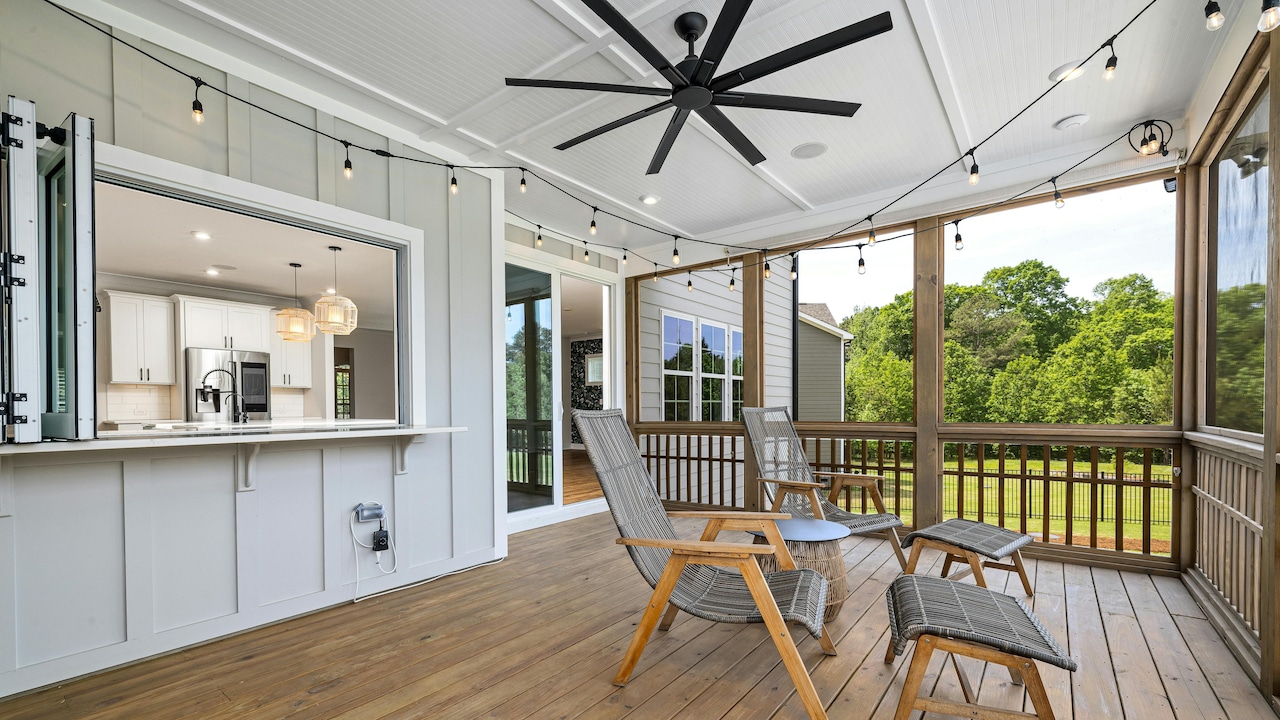How To Choose Ceiling Fans That Stay Dust-Free: Guide To Blade Materials And Anti-Dust Technologies
Tired of climbing up to clean your ceiling fan? Modern ceiling fans are now built to resist dust, thanks to advanced blade materials and anti-dust coatings. Let's explore how to pick a fan that won't turn into a dust collector within weeks.

Ceiling Fans That Do Not Attract Dust: What Blade Material And Coating To Choose.
Picture this: a bright Sunday morning, the aroma of chai wafting through the air, and your living room basking in sunlight. But just as you look up, there it is, your ceiling fan, wearing a thick, grey coat of dust. No one enjoys cleaning it, yet it's unavoidable in a country where dust is as common as monsoon humidity. Traditional fans tend to become magnets for dust, especially in cities with high pollution levels or in homes near busy roads.
But modern innovations are changing the game. Manufacturers have realised that good design isn't just about looks or airflow, it's also about staying clean longer. From special blade materials to electrostatic-resistant coatings, there's a lot more behind the humble ceiling fan than meets the eye. Know how to choose ceiling fans that resist dust buildup with this guide to advanced blade materials, smart coatings, and modern anti-dust technologies for cleaner airflow.

Ceiling Fans That Do Not Attract Dust: What Blade Material And Coating To Choose; Photo Credit: Pexels
Understanding the Secret Behind Dust-Resistant Ceiling Fans
1. Why Ceiling Fans Attract Dust in the First Place
Before finding a solution, it helps to understand the problem. Dust doesn't simply settle, it's drawn in by static electricity. When fan blades spin, they build up a charge, pulling dust particles towards them like a magnet. Add moisture, cooking grease, or pollution to the mix, and it sticks stubbornly.
In hot, dry regions or during construction seasons, airborne dust multiplies. Fans with metallic blades or glossy paint trap even more grime. Once dust sticks, airflow decreases, efficiency drops, and even your electricity bill can creep up. So, it's not just about looks, keeping your fan clean also means keeping your room cooler for less.
The good news? Manufacturers now use advanced surface technology to counter this issue. The secret lies in choosing the right blade material and the coating that covers it.
2. The Role of Blade Material: More Than Just Looks
Blade material determines not only the fan's appearance but also how much dust it attracts. Traditional fans use aluminium blades, lightweight and affordable, yes, but prone to static charge. That means more dust. On the other hand, new materials like ABS (Acrylonitrile Butadiene Styrene) polymer or engineered plastics resist static buildup.
ABS blades are a game-changer. They're sleek, durable, and far less likely to hold onto dust. Wooden finish blades, especially laminated ones, are also popular for premium models. These not only look sophisticated but also naturally resist grime due to their smooth, sealed surface.
When comparing, remember this: metallic blades may offer classic charm, but if you live in a dusty area, polymer or composite blades are worth every rupee. They last longer, stay cleaner, and require minimal wiping, just a quick swipe every few months rather than every week.
3. Aluminium Blades: The Old Favourite With a Flaw
Aluminium has been the go-to material for ceiling fans for decades, and it's easy to see why, it's strong, lightweight, and affordable. But here's the catch: aluminium surfaces build static electricity when they move through air. This static charge pulls dust particles in, making the blades look dull and dirty within days.
In areas with high humidity, the problem worsens as moisture helps dust cling tighter. Though aluminium blades often have powder coatings or paint, these don't fully prevent static attraction. If you already own such a fan, a gentle wipe with a microfibre cloth and anti-static spray every month can help reduce buildup.
Still, if you're planning to upgrade, it's wiser to look at new-generation materials designed to resist dust. Aluminium may be cost-effective upfront, but constant cleaning and frequent repainting can make it less appealing in the long run.
4. ABS Plastic Blades: Sleek, Modern, and Dust-Resistant
Fans with ABS plastic blades are becoming the new household favourite. These blades are moulded from durable thermoplastic, giving them a smooth finish that doesn't attract static charges easily. As a result, dust struggles to cling.
They also offer creative design freedom, curved edges, modern shapes, and stylish finishes that suit both contemporary apartments and traditional homes. They're lighter than aluminium, too, meaning they spin faster while consuming less power.
Maintenance is minimal; a quick wipe with a soft cloth does the trick. Plus, ABS doesn't corrode or warp, even in humid climates. The only drawback? They can cost a bit more, but considering how rarely they need cleaning or replacement, it's money well spent. It's like paying once for years of peace, both visual and mental.
Also Read: 5 Decorative Ceiling Fans With Lights For Modern Homes
5. Wooden and Veneer Blades: Natural Beauty Meets Functionality
There's something undeniably warm about wooden ceiling fans. They bring elegance and a touch of earthy comfort to interiors. Modern wooden or veneer blades are treated with a protective layer that seals the wood, preventing dust and moisture from settling in.
Contrary to what many think, these aren't made of solid wood, they're crafted from high-quality composite or laminated wood, which keeps them light and stable. The coating not only enhances their look but also makes them easy to clean.
These fans pair beautifully with minimalist or rustic interiors, creating a sense of calm. While they're on the higher end of the price range, usually starting around ₹6,000 and upwards, their timeless look and low maintenance make them a worthwhile indulgence.
So, if style and function are both on your checklist, wooden blades make a statement, clean, elegant, and quietly luxurious.
6. The Science Behind Anti-Dust Coating
The true hero of dust-resistant fans lies in their coating technology. Leading brands now use advanced nanotechnology to reduce static charge and repel dust particles. These coatings form a thin, invisible shield over the blade's surface, ensuring that dust doesn't stick easily.
Some coatings even have hydrophobic (water-repelling) properties, preventing moisture and grime from combining with dust, a common cause of those stubborn, sticky layers. Fans with anti-dust coatings often claim to reduce cleaning frequency by up to 50%.
The science is simple yet effective: less static charge, less attraction, and less time spent balancing on a stool with a duster in hand. These coatings are now standard in mid- to high-range models, making them a smart pick for both convenience and hygiene.
7. Popular Coating Technologies in the Market
When browsing for fans, you'll notice terms like “Nano Anti-Dust,” “Electrostatic Shield,” or “Dust Guard.” These aren't just marketing buzzwords, they indicate the type of coating technology used.
For example, Nano Anti-Dust coating uses micro-particles that prevent static electricity. Electrostatic Shield coatings go a step further by neutralising charge buildup during operation. Some brands even use a blend of silicone and polymer resins that make the surface ultra-smooth, so dust simply slides off.
Look out for models with certifications or clear lab-test claims about their dust resistance. They might cost ₹300–₹500 more than standard models, but the comfort of not having to clean them every few weeks easily justifies the difference. After all, a cleaner fan means cleaner air and less effort, an everyday luxury that's worth investing in.
8. Energy Efficiency and Dust Resistance Go Hand in Hand
It might surprise many to know that dust-free fans are also more energy-efficient. When dust accumulates on blades, airflow drops, forcing the motor to work harder. Over time, this increases electricity consumption and reduces motor life.
Fans with lightweight ABS or composite blades maintain consistent airflow, even at lower speeds. Combined with energy-efficient BLDC (Brushless DC) motors, they consume up to 50% less power. This means you can enjoy cool comfort all summer and still see lower electricity bills.
So, choosing a dust-resistant fan isn't just about aesthetics, it's about long-term savings. Think of it as upgrading from an old CRT TV to a smart LED: same purpose, but smarter, cleaner, and far more efficient.
9. Maintenance Tips for Keeping Your Fan Dust-Free
Even the most advanced fan benefits from occasional care. Regular light cleaning goes a long way in keeping your fan pristine. Use a microfibre cloth or a slightly damp sponge, avoid harsh chemicals or rough fabrics that can damage coatings.
Turn off the fan before cleaning (safety first!) and gently wipe each blade. For models with anti-dust coatings, a simple monthly wipe is more than enough. Some people also use fabric softener sheets, surprisingly effective at reducing static buildup.
If your home is near a main road or under construction, consider cleaning more often. Also, avoid painting fan blades yourself; factory coatings are specially formulated, and a layer of home paint can ruin their anti-dust properties.
10. Choosing the Right Fan for Your Home
Selecting the perfect fan involves balancing looks, performance, and practicality. For living rooms, go for larger fans with sleek polymer or ABS blades, they stay clean and stylish. Bedrooms benefit from silent, BLDC motor fans with anti-dust coating for uninterrupted sleep.
If you prefer a classic look, choose wooden finish blades, they complement both modern and traditional décor. Always check for anti-dust or electrostatic-resistant labels, and prioritise trusted brands with solid warranties.
Budget models start around ₹2,000, while high-end anti-dust variants may go up to ₹8,000 or more. But remember, you're not just buying a fan, you're buying comfort and convenience that lasts for years.
A little research today saves countless hours of dusting tomorrow. After all, a clean ceiling fan doesn't just spin, it shines.

Ceiling Fans That Do Not Attract Dust: What Blade Material And Coating To Choose; Photo Credit: Pexels
Products Related To This Article
1. LONGWAY Kiger P1 1200 mm/48 inch Ultra High Speed 3 Blade Anti-Dust Decorative Star Rated Ceiling Fan
2. Orient Electric Newly Launched 1200 mm Aeon BLDC PRO
3. Crompton Avancer Prime 1200mm (48 inch) 77 W Decorative Ceiling Fan
4. ACTIVA 1200Mm High Speed 390 Rpm Pure Copper Windsor Anti Dust Coating Ceiling Fan
5. Havells Festiva 1200mm Dust Resistant Ceiling Fan
Ceiling fans may seem ordinary, but with a bit of thought, they can make home life much easier. Choosing the right material and coating means saying goodbye to weekly dusting and enjoying fresher, cleaner air. Whether it's the innovative ABS blades, elegant wooden finishes, or advanced nano coatings, modern fans are proof that technology can make even simple things smarter.
Next time you look up, let it be with a smile, not with a sigh at the sight of dusty blades. A dust-resistant fan is more than an appliance; it's a quiet partner in keeping your home beautiful, breezy, and blissfully clean.
Disclaimer: The images used in this article are for illustration purpose only. They may not be an exact representation of the products, categories and brands listed in this article.























